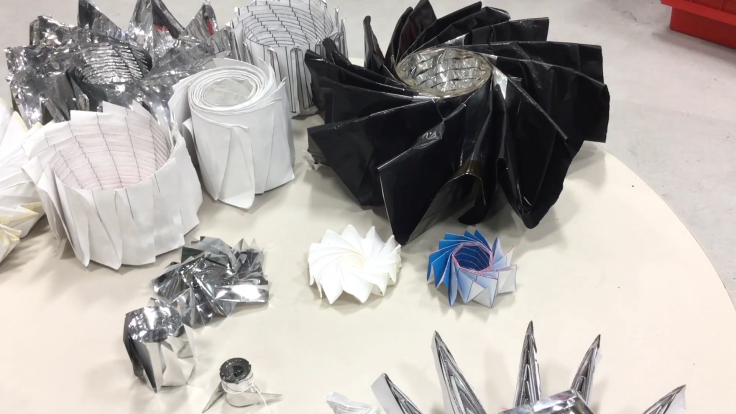NASA Engineers: Tiny, Foldable Spacecraft Designs Are The Future

Future spaceships that humans use to explore other solar systems might be able to fold up and fit into a tiny space, since NASA engineers are exploring foldable designs that could be used on spacecraft today. Smaller and lighter equipment is easier and less costly to launch, making it a more viable option.
This strategy has a root in origami, the paper-folding art that has its roots in Japan. “Origami can seem deceptively simple, hiding complex math within its creases,” NASA’s Jet Propulsion Laboratory said in a statement. “Besides aesthetic beauty, it addresses a persistent problem faced by JPL engineers: How do you pack the greatest amount of spacecraft into the smallest volume possible?”
Folding has a number of different applications, including a proposed spacecraft add-on called Starshade that can unfurl like a flower to shield equipment from the light coming off of stars. Blocking that light could help a spacecraft that is on the hunt for habitable exoplanets, like the James Webb Space Telescope, actually see the planets that are orbiting relatively close to their stars.
Having a shade that folds up when it’s not being used protects the shade from puncture from space rocks.
“The key was developing algorithms that allow the Starshade to fold smoothly, predictably and repeatedly,” NASA explained.
Other space equipment has folded in the past, including things like the solar arrays on the International Space Station.
“A huge part of my job is looking at something on paper and asking, ‘Can we fly this?’” Manan Arya, a JPL technologist, said in the NASA statement. “Once I realized this is how you fold spacecraft structures, I became interested in origami.”
NASA has used folding techniques on more than just machines that fly. Earlier this year, the space agency introduced people to a little robot called PUFFER that might one day roam Mars as a special helper to a larger rover. The robot, whose full name is Pop-Up Flat Folding Explorer Robot, was designed to tuck into small spaces where a rover could not fit, and its wheels fold in on the machine, while still operating, to make it even more compact.
It was proposed that a fleet of PUFFERs could accompany a Mars rover to the Red Planet and be released to perform various tasks as the rover works on other things.
The next step after foldable robots is a NASA project called Transformers for Lunar Extreme Environments, which aims to use foldable mirrors that would aim sunlight at the moon to “melt water ice or power machinery,” NASA said.
The team on that project tests foldable designs with paper or with Kapton, a material that doesn’t crease and is used for insulation on spacecraft.
“The challenge about it that I love the most is that in origami every fold is intimately and geometrically tied to every other fold in the pattern,” JPL robotics intern Robert Salazar said in a video from NASA. “So to create an adjustment of height or length or width or thickness of any one part affects all of the parts.”
He also said that instead of folding things flat, there is a focus on folding up spherical structures and other shapes.
“There’s something wonderful about being able to fold something at a very small scale and have it capture design principles that can be applied to a variety of scales,” Arya said.
© Copyright IBTimes 2025. All rights reserved.




















